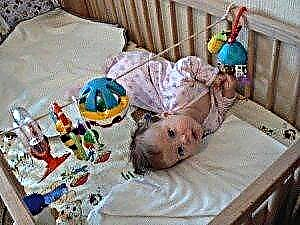The history of the development of each three-month-old baby after the next visit to the pediatrician is replenished with a record on the need to observe the correct daily regimen, which is reduced to the alternation of feedings, sleep, active wakefulness and hygiene procedures.
And here any mother has a logical question: "How to make an unintelligent baby behave in accordance with the strict framework of this prescription?" Let's explain: it is not about following a daily routine, but only about the desire to adhere to certain time guidelines that streamline the life of a 3-month-old baby.

What should be the approximate daily routine of a three month old baby
Approximate daily routine:
- 6:00-7:00 Waking up, feeding the baby in the morning, obligatory hygiene procedures (washing, changing the diaper), air baths, gymnastics, active wakefulness;
- 7:30-9:30 First dream;
- 9:30-11:00 Second feeding, communication with mom, educational games, preparation for a walk;
- 11:00-13:00 Sleep in the fresh air;
- 13:10-13:30 Returning from a walk, third feeding;
- 13:30-15:00 A complex of developing games, taking air baths, communicating with loved ones;
- 15:00-16:30 The second walk, acquaintance with the outside world, sleeping in a wheelchair;
- 16:30-18:00 Fourth feeding, staying awake, playing with family members;
- 18:00-19:30 Sleep;
- 19:30-21:00 Fifth feeding, quiet games surrounded by household members;
- 21:00 Baby bathing;
- 21:30-6:00 Baby feeding, night rest.
More options for the daily regimen for children from 1 to 3 months:
Taking care of her baby and taking into account his individual characteristics, each mother can make some adjustments to the proposed daily regimen, while observing the sequence of actions indicated in it and the duration of the procedures performed.
In accordance with this, the actual daily routine of the baby may differ slightly in time from that recommended by the pediatrician: the intervals between sleep and wakefulness are not always uniform (some babies fall asleep shortly after morning feeding, but then they stay awake for almost three hours). In other children, the routine may shift due to digestive problems and intestinal colic.
Despite all the nuances listed, mothers should not completely abandon the correct daily routine by the hour. Having developed in your baby the habit of eating and falling asleep at certain hours, which contribute not only to his proper development and excellent well-being, but also take care of the rest of the family members.
About sleep mode
The total sleep duration of a three-month-old baby should be about fifteen hours a day. The longest (about eight hours) is the night's sleep. During the day, the baby needs periodic rest, therefore, after two hours of wakefulness, the child needs sleep (at least four times during the day), which takes from one and a half to two hours.
The above alignment can be considered ideal for a 3-month-old baby, but in real life the duration of a night's sleep often does not exceed six hours: waking up in the middle of the night, the baby may require feeding.
In order for a child's daytime sleep to be full and deep, it is necessary to stimulate his activity during wakefulness, giving him the opportunity to move and throw out emotions during the first half of this time period. About half an hour before bedding, you should keep your baby busy with something calm. (sing a song, show a colorful picture, consider a toy).
Ways to speed up the baby's sleep
- There should be no problems with falling asleep in a baby receiving breast milk: if one falls asleep at the mother's breast, it is simply transferred to the crib;
- When laying down a bottle-fed baby, a pacifier is often used to help him calm down and satisfy the sucking reflex. It is somewhat more difficult to put an artificial man who does not recognize a dummy (sometimes it is useful to know how to teach a child to a dummy): some children have to be carried in their arms or rocked for a long time, singing lullabies;
- The influx of fresh air significantly speeds up the falling asleep of the baby and increases the duration of his sleep, therefore many mothers, having well wrapped their crumbs, put them to sleep in a stroller standing on the loggia;
- Some babies are helped to fall asleep by soft classical music, birdsong and sounds of nature;
- Rituals (for example, a toy or a diaper placed nearby, a bathing procedure performed at the same hour) also help babies fall asleep well;
- To extend the rest of the restlessly sleeping baby, waving his arms in a dream, a gentle swaddling or the simple presence of mother will help.
An ingenious trick - how to put a child to bed in 1 minute:
On the topic of sleep:
- How to put a child to sleep without tears and whims - https://razvitie-krohi.ru/psihologiya-detey/kak-ulozhit-rebenka-spat-bez-slez-i-kaprizov.html;
- We teach the child to sleep in his crib separately from his mother (video, real stories) - https://razvitie-krohi.ru/razvitie-rebenka-do-goda/kak-priuchit-rebenka-spat-otdelno.html;
- Whether to rock a child before bedtime: how old can you be rock sick - https://razvitie-krohi.ru/razvitie-rebenka-do-goda/kak-ukachat-rebenka-spat.html;
- The child sleeps only in his arms, and you put it awake - is it a problem or not - https://razvitie-krohi.ru/eto-polezno-znat/rebenok-spit-na-rukah.html;
- At what age a child can sleep on a pillow - https://razvitie-krohi.ru/razvitie-rebenka-do-goda/s-kakogo-vozrasta-rebenku-mozhno-spat-na-podushke.html.
About feeding babies and artificial people
According to the regimen, a child at three months who is breastfed should receive breast milk at least six times a day. The daily norm of breast milk is at least 850 ml.
Already at the age of three months it is necessary to gradually increase the intervals between feedings of infants fed "on demand", bringing them closer to the recommended three-hour interval.
The fact is that a grown-up and more actively sucking mother's breast baby, if applied too often (every half hour), risks eating more milk than he needs. As a result, the body, unable to cope with such a volume of food, reacts to it with an allergic reaction, manifested by a scattering of red spots on the delicate skin of the cheeks and the whole body.
[sc: rsa]
Noticing such a symptom in a baby, an inexperienced mother begins to think that the reason for this is some new product introduced into her diet, and begins to deliberately impoverish him, excluding everything. Meanwhile, this problem can be solved by reducing the number of breastfeeding and thereby normalizing the amount of milk supplied to the crumbs.
The number of feedings for a three-month-old baby who is bottle-fed should also be six times, but the intervals between feedings should be at least four hours: this is the amount of time it takes to digest the formula, which is a substitute for mother's milk.
Unlike infants who do not need additional water intake (it is replaced by "front" milk containing a large amount of liquid), artificial people are given water from a bottle. From the last week of the third month of life, they can gradually introduce into their drink a few drops of apple juice (we give the first juice).
We read in detail about how much breast milk or formula a child should eat - https://razvitie-krohi.ru/kormlenie-grudyu/skolko-dolzhen-sedat-novorozhdennyiy.html
How to walk with your baby
The daily regimen that regulates the life of a three-month-old child provides for at least two walks. Their frequency and duration are still dependent on weather conditions. An absolute contraindication for walking with a grown crumb is frost below -15 degrees and heat above forty. You should not go out with your baby also during heavy rain and wind.

Since 3-month-old children are quite inquisitive, they do not fall asleep right away, but only after looking around. It is very useful to get them out of the stroller and, holding them, to acquaint them with the surroundings: pay attention to birds, flowers, animals passing by people. Satisfied with new impressions, the baby will fall asleep faster.
Given the well-developed hearing of a three-month-old child, it is better to choose a quiet square or a deserted street for walking with him. A steady hum coming from a distant highway will not disturb the baby, but he should be protected from harsh sounds. To do this, it is better to raise the stroller hood. If the walk takes place in the warm season, it is better to put on a mosquito net, protecting the baby from the attack of blood-sucking insects.
About the features of wakefulness
The period of time required for a three-month-old child for active wakefulness increases to 8-9 hours a day. A caring mother should make the most of him, having time to feed the baby on time, take care of his delicate skin, take interesting games, go for a walk with him, introducing him to the world around him, do morning exercises and massage.
We read useful articles with video instructions about massage and gymnastics:
- Proper massage for a baby in the first three months of life
- Dynamic gymnastics: benefits and harms for the newborn
- Fitball lessons with a newborn baby (+ a lot of video instructions)
Most often, a child at 3 months is able to be actively awake for two hours. During this period, he can communicate with his mother and loved ones, expressing the stormy joy of their presence with a wide smile, active movements of the arms and legs, and loud hum.
A three-month-old baby can not only quickly turn his head in the direction of the sounds he heard and follow with his eyes moving objects that fall into his field of vision. He likes to lie on his tummy, resting on his palms and watching what is happening around him. The object of research for him is often his own hands: the baby can examine them for a long time and monitor their change in position.
 The arsenal of games used to develop a two-month-old baby can be replenished with new interesting activities for him:
The arsenal of games used to develop a two-month-old baby can be replenished with new interesting activities for him:
- Rattles are still the favorite toys of a 3-month-old baby. Having laid them out in a row (twenty centimeters from the baby), you can see that the child will certainly reach for the one he likes most. He holds the rattle in the handle tenaciously, fully concentrating on the connection that has arisen between the sound it makes and the movement of his own hand;
- If you bring a three-month-old baby to the mirror, you can make him smile and want to look at his own reflection (we also read about the mirror and superstitions). The same delight in him is caused by the observation of the facial expressions of an adult, demonstrating to the baby the change of various emotions on his face;
- Three-month-old children love the game of peek-a-boo, when a family member covers his face with his palms and then shows it, imitating a cuckoo's calling;
- At this age, you can already read books to your baby, showing illustrations;
- Demonstrating the world around the crumbs, it is necessary to point to various objects and name them;
- For the development of tactile sensations, it is necessary to give the crumbs pieces of fabric of different textures;
- A developmental rug equipped with all sorts of bells, soft vibrating toys, squeaks and a host of other interesting effects will be an excellent entertainment for your baby.
About hygiene procedures and gymnastics
Hygiene procedures when caring for an infant baby include the obligatory ritual of morning washing, washing when changing a diaper and bathing... Morning washing is carried out immediately after the child wakes up. After moistening a cotton pad with warm boiled water, they wipe his face (using a separate cotton wool for each eye), not forgetting to walk behind the ears. Cheek skin is treated with special care, removing traces of breast milk and saliva.
We read in detail: hygiene of a newborn baby

The bathing procedure is most often carried out in the evening, although babies on whom it acts in an exciting way can be bathed in the morning. It is most convenient to bathe a baby in a baby bath, using a special stand for this. In the absence of a baby bath, you can use a large bathtub, putting on a special circle around the baby's neck, allowing him to stay in the water in complete safety without the help of his mother's hands. Bathing details - how to bathe a child correctly
When changing a diaper, you should wash your baby, and then apply a thick layer of a special cream to the delicate skin, which helps to avoid the development of diaper rash and skin irritations.
After washing, they immediately proceed to morning exercises. It must necessarily include exercises for flexion and extension of the limbs. Exercise to extend the knees to the sides will help prevent dysplasia of the hip joints.
Taking the baby by the handles, raise them up, spread them widely to the sides, cross them in front of the chest. An excellent end to morning exercises will be a light massage, which consists of stroking the torso and limbs. Be sure to put the baby on the tummy. If the procedure gives him pleasure, you can give it at least twenty minutes.
A well-designed daily regimen, taking into account the physiological characteristics and needs of a 3-month-old baby, is the key to his correct development and good mood not only for the baby himself, but also for all family members.
← daily routine at 2 months daily routine at 4 months →
READ ALSO: Baby development at 3 months and what a baby should be able to do at 3 months: skills at 3 months




